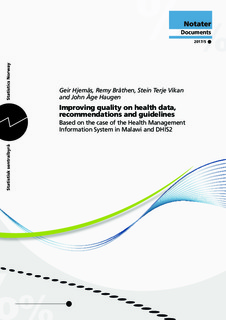| dc.description.abstract | A Health Management Information System (HMIS) is an important element for a country’s capacity to monitor health, and for evaluating and improving the delivery of health-care services and programs. Many developing countries still struggle with quality problems in their HMIS data. With this as a point of departure, this project has a twofold ambition; first to propose methods for improving data quality of HMIS data in Malawi, second to gain insight on how the DHIS2 system in general can improve HMIS data. Statistics Norway’s approach is based on well-known quality methods, involving both statistical methods and evaluating structural and institutional challenges.
HMIS data in Malawi is collected through the District Health Information System (DHIS2). The project achieved to introduce the new DHIS2 quality tool in Malawi, and thus make modern statistical techniques, methods and tools available. In addition, training and local capacity building in the use of these techniques, methods and tools was carried out. In the process it was quickly surmised that, due to lack of quality in the data collected, several other measures needed to be put in place in order to improve the quality of health data in Malawi. Firstly, there is a lack of central control over the process of collecting health data. Multiple agencies are involved, each with its own agenda and field of interest. There is also little or no coordination between the agencies involved. This institutional context has led to a process where vast amounts of data are collected, but these receive little or no quality control. There is need for an implemented strategy for quality control and central data processing. Furthermore, official publication of results has not been regular and no coherent dissemination procedures are in place. Data providers have minimal training in their field of work and there is a high degree of turnover. One last issue is that there isn’t any feedback to the local health officials reporting the data. This reduces their incentives to improve their reporting.
To sum up, Malawi today (2015) has access to the technology and the statistical methods that are associated with the production of data and statistics of sufficient
quality (DHIS2 and the quality tool). What is found lacking are institutional factors surrounding and supporting the process. A lot has been said about developing
countries’ ability to leap-frog stages in technological development and the opportunities such advances provide. But modern technology and methods often depend on a proper institutional context in order for society to reap the benefits of the new technology.
For Malawi to reach their goal of good quality health statistics, the institutional context should be subjected to a deeper analysis. First and foremost, central control over production of statistics by the Ministry of Health should be strengthened. Greater coordination of agencies and reduction in the amount of data collected should be one of the main tasks set for the Ministry of Health. The input side in the data/statistics production chain should receive greater focus. Technology can alleviate some problems with paper-based collection, but several problems remain; lack of training, burdensome amount of data collected and lack of feedback. These problems should be resolved in order to increase data quality. Furthermore, an indepth quality self-assessment should be carried out and an action plan developed to address issues uncovered.
The Ministry of Health, through The Central Monitoring and Evaluation Division (CMED) are motivated to improve DHIS2 data quality. CMED has a central role in this project and have been an active contributing partner, characterised by an approach of openness both by sharing data and working routines | nb_NO |

